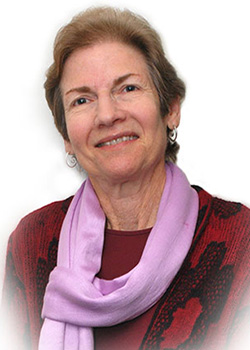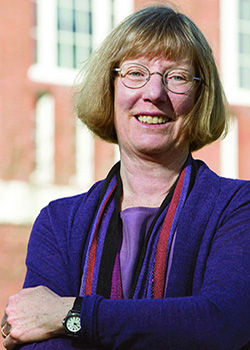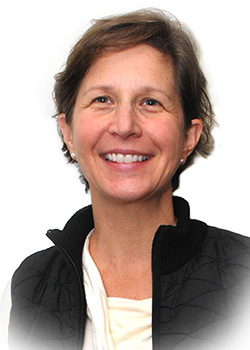Lola Van Wagenen’s Click! Is a Lasting Legacy |
|||||||
| by Rickey Gard Diamond | |||||||
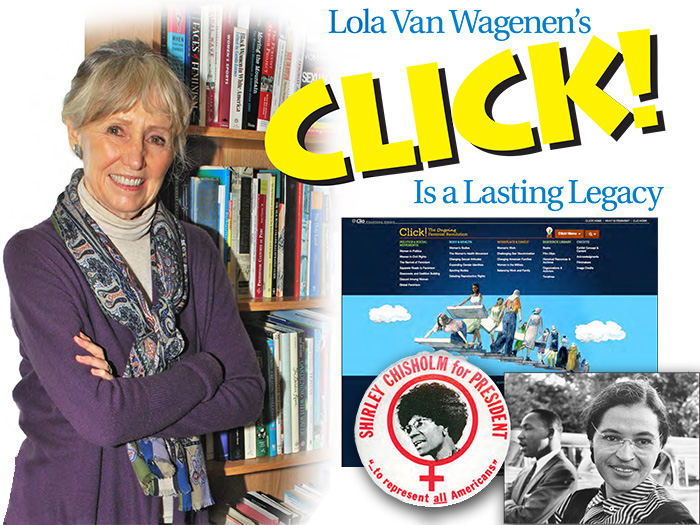 |
|||||||
| Filmmaker, historian & team leader, Lola Van Wagenen photo portraits: Jan Doerler |
|||||||
In a digital world dominated by scary news of ISIS, a blowhard Trump, climate change, Hillary’s “damned” e-mails, and nothing happy except for kitten videos, something hopeful is about to be born—an exciting new online resource called Click! Its midwives are five formidable women historians, four of them Vermonters and three longtime girlfriends. While they all tend toward modesty, despite five whole years of attentive work, Click! is huge. It will be a game changer. Its name has a timely double meaning: click is the action taken to navigate computers and make Internet connections. And click also denotes those feminist moments when you suddenly see that what you have blindly accepted you won’t next time. Click! will benefit every woman and man who wants to better understand the women’s movement and what these five historians call our “ongoing revolution.” The struggle they describe is not a war but women’s simple and nonviolent insistence on democracy for all. The project’s originator is Vermont historian and filmmaker Lola Van Wagenen of Shelburne. About Click!’s design, she says: “We wanted to make something everyone could use, like an online museum. Some will really get into it, or they might just walk through it.” Her organization Clio, begun in 1996 at www.cliohistory.org, has long provided visual history resources to educators and researchers; it will host the new online exhibit. In Greek mythology, Clio was the muse of history. And those who worked on this project agree that Van Wagenen was the inspiring, driving muse that brought this all together.
|
|||||||
 |
|||||||
|
What will you see when you go there? The conflicts women faced will be familiar ones for those who have lived through the changes, though the site’s time lines reveal many issues’ intersections. Younger women may be surprised, seeing the lives of their mothers and grandmothers in context—like discovering the word sexism didn’t exist before 1965; it used to be “normal.” Since women won the vote in 1920, waves of mothers and daughters of distinct ethnicities, races, and sexual preferences have changed our collective perspectives on “Politics & Social Movements,” our “Body & Health,” and on “Workplace & Family”—the three interlinked pages or chapters of this online exhibit. Both text and film excerpts reside within each of the three exhibit chapters, revealing events dating back to World War II. Film clips enable you to meet the women involved and hear and see those who have made huge differences in our lives the past 50 years—some of them famous, most of them not. Click! will make it much harder to “forget” the uppity women of every background who confronted racial, sexual, and economic prejudices. The struggles within the movement also become visible, as well as the pushback from those fearing change, and the intertwining of issues we still live with today. Each of the chapters has a time line, divided into a stack of colorful boxes. Each box names a date and subject. Click on a box, and it opens to take you to brief texts, links to other sites and archives, seminal books, and sometimes film clips that show you women’s involvement. Diverse as the women themselves, topics include the efforts of Chicanas, Arabs, and Native Americans; conservatives like Sarah Palin; the hearings on Anita Hill; the Lesbian Avengers; and Asian immigrant advocates. At times, navigating the time line zooms you to a section you hadn’t intended— mostly fun, with frustrations pretty typical for website users. The return is well worth it, every box a surprise. The time line for Political & Social Movements includes: 1941, Jeanette Rankin and WWII; 1955, Montgomery Bus Boycott; 1971, The Click! Moment; and 2012, White House Barbie Doll. Some events and subjects are not exclusive to women, such as, in this chapter, Montgomery Bus Boycott, Kent State, and Stonewall.
|
|||||||
|
These multiple layers were the goal of Van Wagenen’s team from the beginning, she says. Van Wagenen chose each team member for her particular expertise and skill. Each had won her regard through personal associations, some decades long. For example, she and Melanie Gustafson, now a history professor at UVM, had been grad students together at NYU; team writer and biographer Susan Ware, who lives in New Hampshire and Cambridge, Massachusetts, was advisor to both of them there and later worked with Van Wagenen on Clio’s film projects and other web exhibits. Historian and author Marilyn Blackwell of East Montpelier is the fourth team member, who worked with Van Wagenen at the Vermont Historical Society. “We lived through the movement,” says Van Wagenen of these women. Wanting to appeal to younger women, too, she reached out to Amy Morsman, a women’s history professor who had taught and made an impression on her granddaughter, Michaela, at Middlebury College. Van Wagenen credits her granddaughter’s younger generation for her motivation: “They don’t know what it was like in the 1950s. The 1940s for them is ancient history.” Morsman says as soon as the project goes live on November 6, she will invite her 38 undergrad students to explore it and give them feedback. Gustafson called Van Wagenen’s commitment to building bridges between academics, public schools, and community groups “profound,” and several of her team remarked that she had exactly what was needed to lead the project. Van Wagenen created documentary films at Clio, including one that was aired on PBS’s program American Experience, a contextual history on Miss America. “But in the worsening political climate,” says Ware of their work at Clio, “we would put together these fantastic proposals, and they weren’t funded. It was a really frustrating experience. Lola was the one who saw the potential for a website long before anyone.”
|
|
||||||
Van Wagenen’s response to this discouraging turn of events, which might have stopped others, was matter-of-fact. “I said: Well, look. We’ve got this material. Let’s just put this up online. We don’t have to raise $300,000 to make a film. Let’s figure out how to use this new media,” she says with a shrug in her voice. “It was repurposing.” She is proudest of her team. “I chose people who respected each other,” she says. “We set up a private blog, and wherever anyone was, she could post her ideas or comment. In all this process, we never argued. We disagreed. Historians disagree about everything.” She laughs and says they blogged for a full year before deciding how exactly to organize things. It required careful planning and sifting and revising to determine what was possible to include. “There were five of us at the table. It just grew!”
|
|||||||
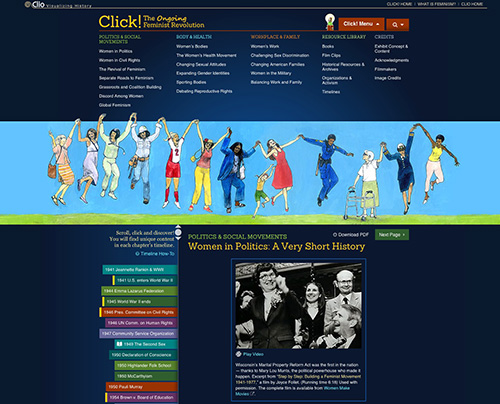 |
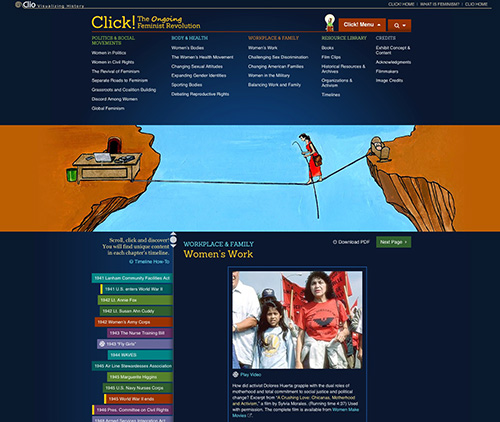 |
||||||
|
None of them dreamed it would take so long, she says. Some of the team talked about worries that important things had been left out. Says Blackwell, “We really wanted to appeal to people who weren’t familiar with this history. Narrowing it down meant we had to get to the core.” Women and religion, women and the arts, women and literature are sometimes mentioned, but Click! had to make hard choices. As it is, Morsman worries that the information they have gathered might be overwhelming. Van Wagenen is not concerned. “If we screwed up anywhere, we’ll gladly make changes. We’ll continue to get feedback. That’s one of the reasons we included the time line. If people want more detail, they can find primary documents.” Another significant part of the website is the Resource Library. The library includes extensive bibliographies on each of the three chapters already named, plus the whole film clip collection by subject, as well as historical archives for further research and links to organizations for activism. Another element that required their flexibility and commitment was the changing nature of the Internet in the years they worked on it. “Over time, the tools changed,” Van Wagenen says of software changes and redesigns. Her assistant Connie Beliveau’s technical background was invaluable to this process, she and other team members say, as were the artists, designers, and website creators credited on the site. Students, teachers, and lifelong learners, whether browsing or looking for answers to a question or some specific subject, will appreciate the site’s search ability. Be certain to check “essays, library, timelines,” or the safe bet: all three. Testing it out the first time, without checks, I got zero hits, but checking the right little boxes, I got 55 items for “conservative” and five for Phyllis Schlafly. There’s something here for everyone.
|
|||||||
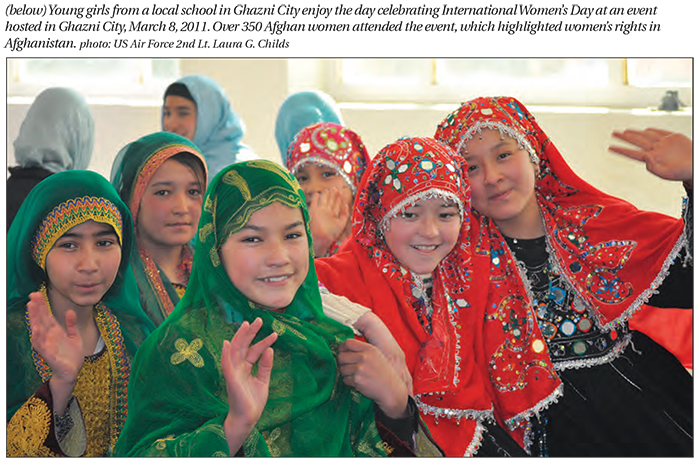 |
|||||||
|
Ten years ago, when Van Wagenen first began her organization, streaming films was not possible. As the technology changed, so did her methods for Click!. “At first we thought we’d have interviews, we thought we’d make a film. But there are all kinds of women’s films. So rather than make films, we approached filmmakers about using clips. Joyce Follett, who filmed Step by Step: Building a Feminist Movement, 1941–1977, said, ‘I would love to have some of my films seen!’” Catherine Russo, too, was an important resource; she filmed A Moment in Her Story, about the Boston women’s movement. “These films get made with love,” says Van Wagenen. “They just don’t get widely seen.” Van Wagenen decided to contact Women Make Movies, an organization established in 1972 that facilitates the production, promotion, distribution, and exhibition of independent films and videotapes by and about women, for help in getting access to films. Excited about Click!, Women Make Movies began helping beyond Van Wagenen’s expectations, becoming an active liaison with filmmakers. Especially exciting was discovering a 30-year-old film by Joanne Grant on Ella Baker, the overlooked mother of the civil rights movement who began organizing in 1938. “The generosity of the filmmakers floored me,” Van Wagenen says. Filmmakers and writers and all contributors are fully documented on the site, Van Wagenen’s professional standard. Ware says, “Lola gave people recognition and publicity, in the whole long section at the end, all the permissions. We identified our sources, so if people want to follow up, they can do that. She had a commitment to recognize [everyone], not just the five of us who came up with this—we were drawing on the talents of researchers, archivists, writers, and filmmakers. I think that’s a fairly feminist approach to inclusiveness.” Which brings us to the subject of feminism itself, or what we used to call at Vermont Woman, the other “f-word,” because its use, early on, resulted in our losing advertising sales. At the very, very top of the Click! webpage, in an inconspicuous spot in small type is the question, “What is feminism?” Click on that one, I dare you. You’ll find The American Heritage Dictionary definition: 1. Belief in the social, political and economic equality of the sexes and 2. The movement organized around this belief. The site’s text inquires: “Why has such a seemingly simple and straightforward notion about the equality of the sexes been demonized to such an extent that many Americans shy away from it, even when they admit that they are in agreement with many of its basic goals?” The answer is an essay, with various key books cited, and another time-line stack of boxes, with their varying content—text, films, including the famous bra-burner images, and real women, speaking from many perspectives, to throw light on the subject. For those of us who have sometimes felt weird, it is a real confirmation, a heart-warming thrill, to discover you are far, far from alone. |
|||||||
